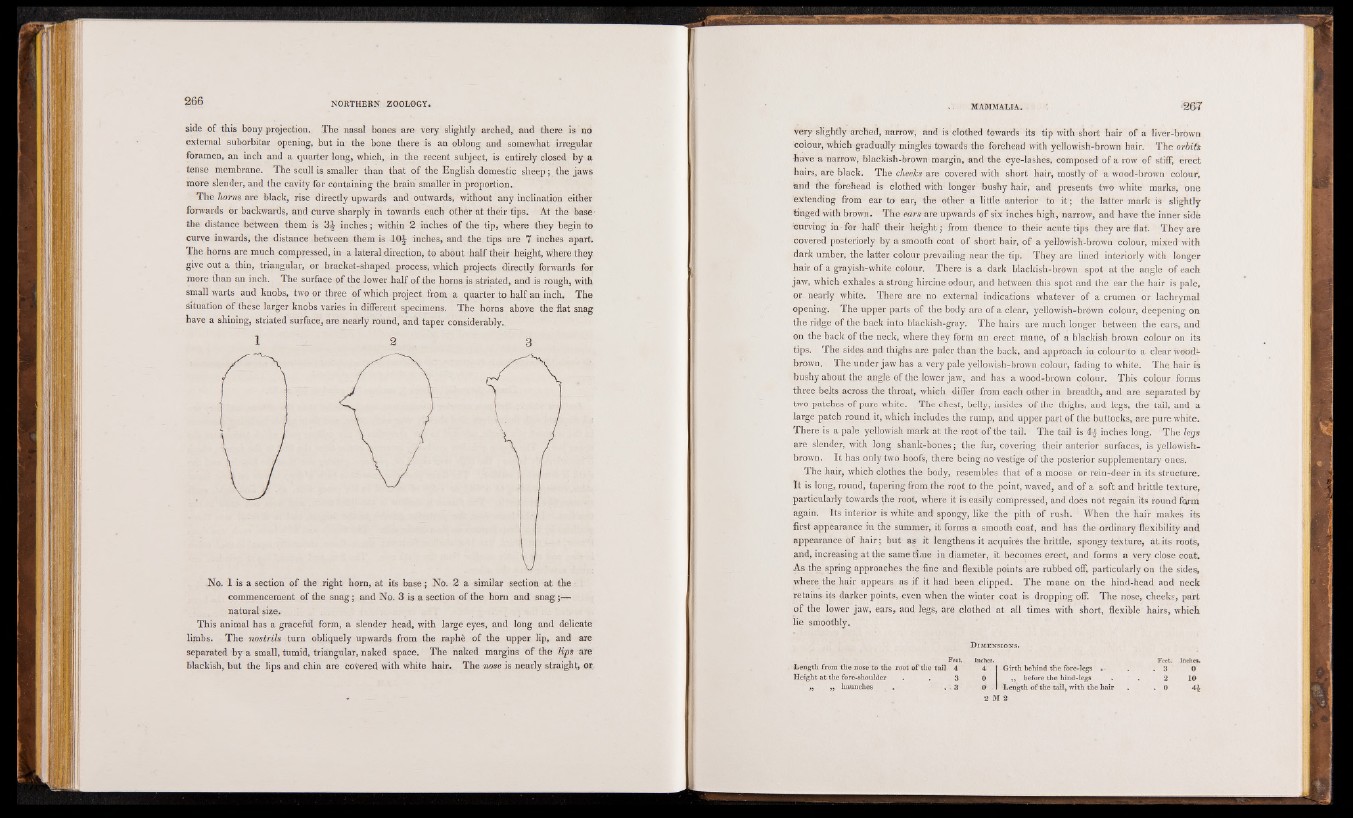
side of this bony projection. The nasal bones are very slightly arched, and there is no
external suborbitar opening, but in the bone there is an oblong and somewhat irregular
foramen, an inch and a quarter long, which, in the recent subject, is entirely closed by a
tense membrane. The scull is smaller than that of the English domestic sheep; the jaws
more slender, and the cavity for containing the brain smaller in proportion.
The horns are black, rise directly upwards and outwards, without any inclination either
forwards or backwards, and curve sharply in towards each other at their tips. At the base-
the distance between them is 3^- inches; within 2 inches of the tip, where they begin to
curve inwards, the distance between them is 10^ inches, and the tips are 7 inches apart.
The horns are much compressed, in a lateral direction, to about half their height, where they
give out a thin, triangular, or bracket-shaped process, which projects directly forwards for
more than an inch. The surface of the lower half of the horns is striated, and is rough, with
small warts and knobs, two or three of which project from a quarter to half an inch. The
situation of these larger knobs varies in different specimens. The horns above the flat snag
have a shining, striated surface, are nearly round, and taper considerably..
No. 1 is a section of the right horn, at its base; No. 2 a similar section at the
commencement of the snag; and No. 3 is a section of the hom and snag;—
natural size.
This animal has a graceful form, a slender head, with large eyes, and long and delicate
limbs. The nostrils turn obliquely upwards from the raphfc of the upper lip, and are
separated by a small, tumid, triangular, naked space. The naked margins of the Kps are
blackish, but the lips and chin are covered with white hair. The nose is nearly straight, or
very slightly arched, narrow, and is clothed towards its tip with short hair of a liver-brown
colour, which gradually mingles towards the forehead with yellowish-brown hair. The orbits
have a narrow, blackish-brown margin, and the eye-lashes, composed of a row of stiff, erect
hairs, are black. The cheeks are covered with short hair, mostly of a wood-brown colour,
and the forehead is clothed with longer bushy hair, and presents two white marks, one
extending from ear to ear, the other a little anterior to i t ; the latter mark is slightly
tinged with brown. The ears are upwards of six inches high, narrow, and have the inner side
Curving in for half their height; from thence to their acute tips they are flat. They are
covered posteriorly by a smooth coat of short hair, of a yellowish-brown colour, mixed with
dark umber, the latter colour prevailing near the tip. They are lined interiorly with longer
hair of a grayish-white colour. There is a dark blackish-brown spot at the angle of each
jaw, which exhales a strong hircine odour, and between this spot and the ear the hair is pale,
or nearly white. There are no external indications whatever of a crumen or lachrymal
opening. The upper parts of the body are of a clear, yellowish-brown colour, deepening on
the ridge of the back into blackish-gray. The hairs are much longer between the ears, and
on the back of the neck, where they form an erect mane, of a blackish brown colour on its
tips. The sides and thighs are paler than the back, and approach in colour to a clear wood-
brown. The under jaw has a very pale yellowish-brown colour, fading to white. The hair is
bushy about the angle of the lower jaw, and has a wood-brown colour. This colour forms
three belts across the throat, which differ from each other in breadth, and are separated by
two patches of pure white. The chest, belly, insides of the thighs, and legs, the tail, and a
large patch round it, which includes the rump, and upper part of the buttocks, are pure white.
There is a pale yellowish mark at the root of the tail. The tail is 4 \ inches long. The legs
are slender, with long shank-bones; the fur, covering their anterior surfaces, is yellowish-
brown. It has only two hoofs, there being no vestige of the posterior supplementary ones.
The hair, which clothes the body, resembles that of a moose or rein-deer in its structure.
It is long, round, tapering from the root to the point, waved, and of a soft and brittle texture,
particularly towards the root, where it is easily compressed, and does not regain its round farm
again. Its interior is white and spongy, like the pith of rush. When the hair makes its
first appearance in the summer, it forms a smooth coat, and has the ordinary flexibility and
appearance of hair; but as it lengthens it acquires the brittle, spongy texture, a t its roots,
and, increasing at the same time in diameter, it becomes erect, and forms a very close coat.
As the spring approaches the fine and flexible points are rubbed off, particularly on the sides,
where the hair appears as if it had been clipped. The mane on the hind-head and neck
retains its darker points, even when the winter coat is dropping off. The nose, cheeks, part
of the lower jaw, ears, and legs, are clothed at all times with short, flexible hairs, which
lie smoothly..
Dimensions.
Feet. Inches. Feet. Inches.
Length from the nose to the root of the tail 4 4 1 Girth behind the fore-legs . - . 3 0
Height at the fore-shoulder . . 3 0 I ,, before the hind-legs . 2 10
,, „ haunches . , 3 0 - 1 Length of the tall, with the hair . 0
2 M 2